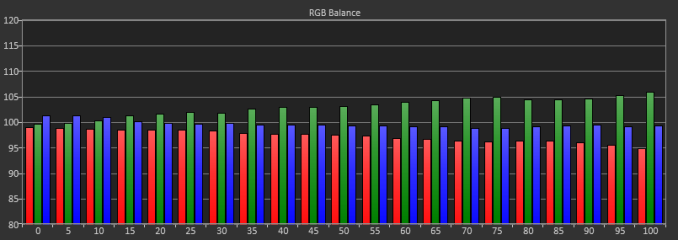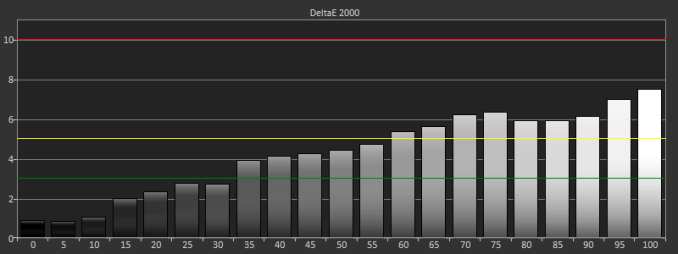Dell U3014 LCD Review
by Chris Heinonen on April 15, 2013 2:00 PM ESTThe U3014 ships with a copy of Dell UltraSharp Color Calibration Solution on the CD but doesn’t include the necessary hardware. For this you actually need to buy an i1Display Pro meter, though you can order it off Amazon or anywhere else and not just directly from Dell. One thing to note is that you need to use the retail i1DisplayPro meter and not the OEM version, as they have a different hardware ID and companies have to buy the licenses for each type separately from X-Rite. For 99% of you this won’t be an issue, but it meant my i1DisplayPro didn’t work as it’s an OEM one that some calibration software requires, and so Dell provided me with a brand new one. This is really an X-Rite issue as they added this restrictive licensing that didn’t exist on their old hardware, but it’s something to be aware of.
Using the Color Calibration Solution is really quite easy. You hook up the i1DisplayPro meter, choose your targets, and let it work. You can set up two custom settings in the CAL1 and CAL2 settings on the monitor, and you can choose from common colorspaces or a custom one. This makes it very easy to set up an sRGB and AdobeRGB calibration, Day and Night calibrations, or any other combination. One thing I wish Dell did let you do was rename them in the display, as Day and Night would be easier to remember than CAL1 and CAL2.
Dell also needs to provide some post-calibration measurements showing the difference from before and after. LGs calibration package does this, but the Dell software just finishes and installs the profile with no numbers, charts, or side-by-side examples to show you what it did. One would assume it gets very close to the target, but you really have no idea at all unless you measure with another software package. That’s mighty inconvenient to have to do.
The main issue I have with the Dell software, which we will see shortly, is that it only supports the i1DisplayPro. Being a colorimeter and not a spectrometer, the i1DisplayPro is very good at reading levels of light but can be confused by irregular wavelengths of light. Since the U3014 uses a brand new G-B LED array that has different wavelengths than most monitors, that means the i1DisplayPro is likely to interpret data from it incorrectly unless it has a custom response table built for each individual meter. With the U3014 aiming directly at the upper-end of the marketplace, it needs to include support for spectrometers like the i1Pro as well to do a better job calibrating it.
To show the difference this makes, I made three sets of measurements after the Dell software finished its calibration. The first set is using the i1DisplayPro that the software uses to do the calibration. The second is using an i1Pro meter, which is a spectrometer. The third is using a C6 colorimeter, which is basically a slightly customized i1DisplayPro, but which has been profiled in CalMAN using the i1Pro so it knows how to read the light spectrum from the U3014.
First up, let’s look at the grayscale numbers. Using the i1DisplayPro, we see there is a heavy green shift, with a bit of blue at times, and red is really low. However, if we switch to the i1Pro or the profiled C6, we see that red and green are high and blue is low. Our average CCT switches from 6826K, a blue tint, to 6325K, a reddish tint. If you’re comparing results and it’s not a very dark screen (below 10 cd/m2), the spectrometer is going to be correct, not the colorimeter. Here we see that the Dell software might think it’s getting a better result than it is, because the i1DisplayPro can’t read the light output properly.

Looking at the Grayscale dE2000 data, we actually see a huge error when only using the i1DisplayPro, with an average dE of 4.3 whereas the C6 and i1Pro see errors of 1.99 and 2.12 respectively. I lean to the C6 numbers over the i1Pro as it can read 20% and below much better, which means that data is going to be more accurate. We still see that we get totally different results from the same screen using the different meters, and we get worse data from the i1DisplayPro itself, which I didn’t expect to see.

This carries over into the Gretag Macbeth charts as well, where we see a much higher average dE2000 (2.96) with the i1DisplayPro than we do with the C6 (1.59) or the i1Pro (1.68). This is mostly grayscale error, but skin tones and oranges in particular are also poor. It might be that those wavelengths are the ones the i1DisplayPro has trouble reading correctly, and so its picking up less red than it should. This would account for almost all of these issues, but it still shows the problems with only using a single colorimeter that hasn’t been profiled for the display it is being used on. These problems only grow as you use custom backlights that have a new spectral signature.

In the end, the Dell software gets you closer than the default, and if you have an i1DisplayPro that you can use I’d go ahead and use it. However, if you have access to something like an i1Pro or other spectrometer, you could use ArgyllCMS and one of the free front ends like dispcalGUI to get better results because it can read the light correctly. If Dell can add support for the i1Pro or another spectrometer, or even better allow you to profile the i1DisplayPro off an i1Pro, then their software would be very nice to use. Considering its free, this might seem like a lot of complaints, but I wouldn’t want someone to buy the U3014, use the software and their suggested meter, and think they have a perfectly calibrated display when we can see that isn’t actually the case.
















84 Comments
View All Comments
Filiprino - Wednesday, April 17, 2013 - link
Your source of lag must be the use of HDMI.cheinonen - Thursday, April 18, 2013 - link
HDMI and DisplayPort were virtually identical in this regard.red5un - Wednesday, April 17, 2013 - link
How does the new dell stack up against the NEC PA30 color wise? Love your new testing methodology but I wish there was a way to see a direct comparison. Is there a possibility of you guys retesting some of the higher end monitors? Are LED monitors finally ready to do color critical work? We do print and commercial VFX work and the NEC's are great but recalibrating every week plus knowing the CFL's are slowly dying I'm wondering if LED will be the answer.cheinonen - Thursday, April 18, 2013 - link
I have no idea how the NEC 30" would fare, as I only tested the 27", and that was with the older test format. Getting in an older monitor is less likely to happen, if only because manufacturers often don't have review samples of displays that are older laying around anymore. I'll see what possibility exists, though it would more likely just be a quick review with only the test data, and not the in-depth commentary, since that has been covered before.soerenL - Thursday, April 18, 2013 - link
Thanks for enlightening article!New to wide gamut and display profiling, have been reading a bit about it around the net, but would like know if my workflow makes any sense. Asked this in Dell forums also, apologies in advance if this is the wrong place to ask!
My primary objective is to have accurate colors in Maya and Photoshop. Secondary objective is to have accurate colors in games.
I should use sRGB emulation in Maya, and other non color managed applications, and adobeRGB in photoshop and firefox ?
I should profile the display with the provided Dell UltraSharp Color Calibration software, and store a sRGB calibration profile for example in CAL1, and a adobeRGB calibration profile in CAL2. And have the Dell Display Manager switch to CAL2 when using photoshop, and to CAL1 for all applications that aren't color managed ?
i1Profiler (the software that came with the i1Display Pro) can monitor ambient light, and automaticly reprofile based on changes in ambient light. The Dell UltraSharp Color Calibration software doesn't mention measuring ambient light at all, so I don't think the software have that capability ? Is there a way of using the hardware calibration in U3014 and ambient light measurements at the same time ? Would it be ok to install both i1Profiler and the Dell UltraSharp Color Calibration software, at the same time, do first the hardware calibration with the dell software, and then have the i1Profiler build a (software?) profile, that would mostly just reflect changes in ambient light ?
For accurate colors in games (if at all possible) I should use the games preset (to reduce lag) and then use i1Profiler to create a profile ?
sherlockwing - Friday, April 19, 2013 - link
For $1400 Dell should at least consider going up to 2880X1800 for a 16:10 monitor.Zibri - Friday, April 19, 2013 - link
I still think 2010 HP ZR30W is better than this.Oxford Guy - Sunday, April 21, 2013 - link
The u2412m has higher contrast because it's e-IPS. e-IPS has a simpler pixel structure that allows more light to be transmitted. However, e-IPS monitors always come with just 6-bit color and the thin paper used in the u2412m leads to mediocre uniformity.Also, there isn't a single A-MVA panel in your chart which makes your black level/contrast ratio comparison lack adequate perspective. You should include the best and the poorest in your charts, to provide perspective -- especially the best. The best contrast ratio would be from A-MVA.
ZoeAnderson24 - Monday, April 22, 2013 - link
Henry. true that Jean`s comment is terrific... on saturday I got themselves a Mazda after earning $4127 this last four weeks and-a little over, ten-k lass month. without a doubt its the most-financialy rewarding I've had. I started this 6 months ago and right away began to bring home more than $75... p/h. I use this here great link,, All29.comCHECK IT OUTBig Anonymouse - Tuesday, April 23, 2013 - link
Great article!Btw, how come the lag numbers are diametrically opposite to the ones in http://www.tftcentral.co.uk/reviews/dell_u3014.htm review, where it scored with the lowest lag compared to all tested monitors (some of them tested in this article too)? Could you have perhaps resetted the "Game Mode" setting by accident, or something similar?